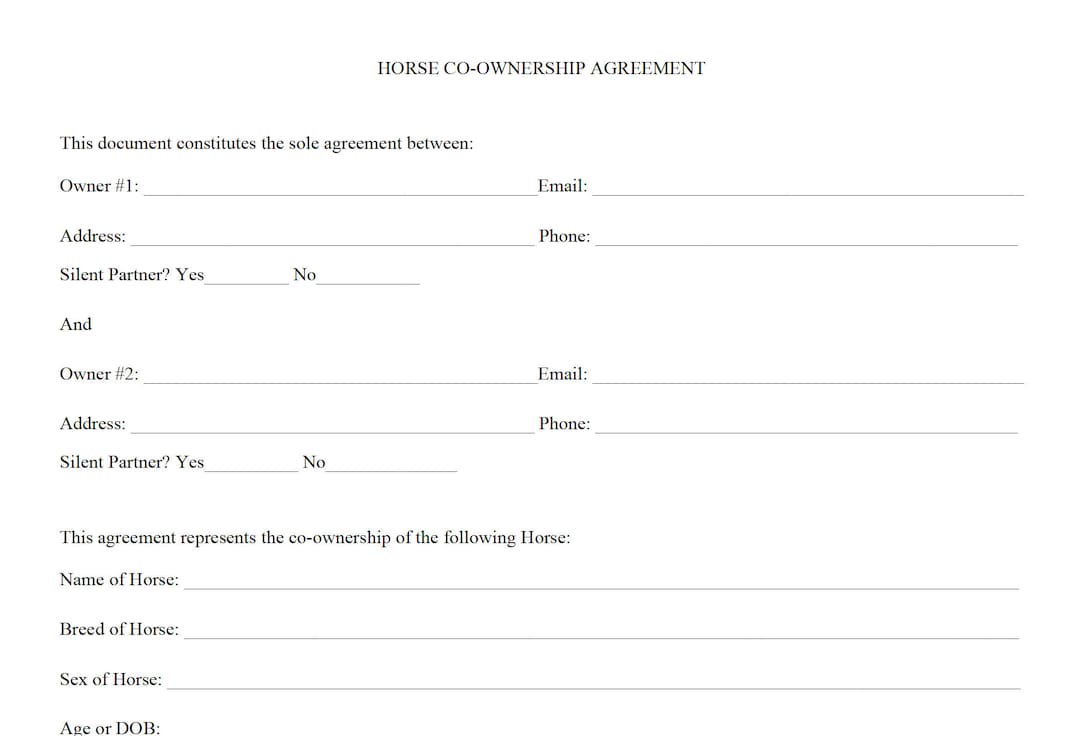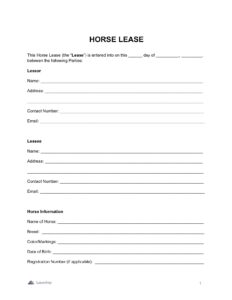Thinking about sharing the joy and responsibility of owning a horse with someone else? It’s a fantastic idea! Imagine splitting the costs, the work, and the sheer delight of having a horse in your life. But before you dive headfirst into this equestrian adventure, it’s absolutely crucial to have a solid shared horse ownership agreement template in place. This document will be your guiding star, helping to navigate the complexities and ensure a smooth and harmonious partnership for everyone involved. This article is aimed at guiding you through the process.
Shared horse ownership can be incredibly rewarding. You’ll have a partner to share the daily chores, the vet bills, and of course, all the amazing moments of riding, grooming, and simply spending time with your equine friend. However, it’s essential to remember that even the best friendships can be strained by disagreements over money, care decisions, or riding schedules. That’s where a well-crafted agreement becomes invaluable.
Think of a shared horse ownership agreement template as a roadmap for your partnership. It clearly outlines each owner’s rights, responsibilities, and financial obligations. It addresses potential conflicts before they arise, providing a framework for resolving disagreements fairly and amicably. With a comprehensive agreement in hand, you can focus on what truly matters: enjoying the companionship of your horse and building a strong, supportive partnership.
Why You Absolutely Need a Shared Horse Ownership Agreement
Let’s face it: even the most well-intentioned partnerships can run into snags. When it comes to something as emotionally and financially involved as horse ownership, having a crystal-clear agreement is non-negotiable. It protects everyone involved, ensures the horse’s well-being, and minimizes the risk of misunderstandings that could damage friendships or lead to costly legal battles. A solid agreement acts as a safeguard, outlining expectations and responsibilities in detail.
Imagine this scenario: you and your co-owner disagree on the type of feed the horse should receive. You believe in a high-fiber diet, while your partner prefers a grain-heavy approach. Without a written agreement specifying how such decisions should be made (perhaps through a majority vote or consultation with a veterinarian), the disagreement could escalate into a major conflict. A comprehensive shared horse ownership agreement template will help you manage these situations.
A good agreement will cover essential aspects like: ownership percentages, defining who owns how much of the horse; financial contributions, clearly outlining how expenses like board, vet bills, farrier services, and insurance will be divided; care responsibilities, detailing who is responsible for daily feeding, grooming, and exercise; riding schedules, outlining how riding time will be allocated among the owners; decision-making processes, describing how important decisions regarding the horse’s care and training will be made; and dispute resolution, defining a process for resolving disagreements amicably.
Furthermore, the agreement should address what happens if one owner wants to sell their share, or if the horse becomes injured or ill. It should also clarify what happens if one owner can no longer afford their share of the expenses. Planning for these potential scenarios in advance can prevent significant headaches down the road.
What to Include in Your Agreement
While every agreement will be unique to the specific circumstances of the partnership, some key elements are essential. Start with a detailed description of the horse, including its name, breed, age, color, and any distinguishing markings. This helps to avoid any confusion about which horse the agreement pertains to.
Key Elements of a Comprehensive Shared Horse Ownership Agreement Template
A well-structured shared horse ownership agreement template is more than just a formality; it’s the bedrock of a successful and enjoyable partnership. It addresses potential challenges proactively, preventing misunderstandings and ensuring the horse’s well-being is always the top priority. Here are some essential elements to consider when crafting your agreement:
Firstly, clarify the ownership structure. Is it a 50/50 split, or are there different ownership percentages? This will impact how decisions are made and how profits (or losses) are divided if the horse is eventually sold. This should be clearly outlined so that there is no future confusion about who owns what part of the horse.
Secondly, create a detailed financial plan. This includes not only the monthly board and care expenses but also unexpected costs like emergency vet visits or specialized farrier work. Specify how these costs will be divided (proportional to ownership percentage, perhaps?) and how payments will be tracked. Consider creating a joint bank account specifically for horse-related expenses to enhance transparency.
Thirdly, define the care responsibilities. Who is responsible for daily feeding, grooming, turnout, and exercise? Will these tasks be shared equally, or will one owner take on more responsibility in certain areas? If you plan to hire outside help, such as a groom or trainer, specify how those costs will be covered and how decisions regarding their services will be made. Discuss the process for vet and farrier appointments, ensuring both parties are informed and agree on the treatment plan.
Fourthly, address the riding schedule. How will riding time be allocated among the owners? Will there be a set schedule, or will you coordinate on a weekly basis? Consider factors like skill level, riding goals, and availability when determining the schedule. It’s also crucial to discuss whether other people will be allowed to ride the horse and under what conditions.
Finally, establish a clear dispute resolution process. Disagreements are inevitable, but how you handle them can make or break the partnership. Consider including a clause that requires mediation before resorting to legal action. This can save time, money, and emotional distress. The goal is to create a framework for resolving conflicts amicably and in a way that is fair to all parties involved.
Starting this journey with a shared horse ownership agreement template will make things a lot easier. Remember to be clear and concise in everything you write.
Shared horse ownership is a beautiful way to enjoy horses in companionship. With a little bit of preparation, it can be very rewarding.


